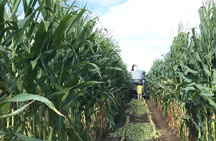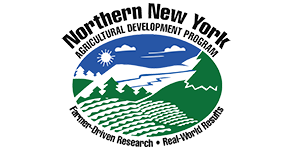
July 16, 2020. Cornell University researchers with a grant from the Northern New York Agricultural Development Program (NNYADP) say individual farm growing conditions and field management may play a larger role than previously credited in maximizing corn production. The research team’s latest variety trials and nitrogen uptake efficiency report is posted on the NNYADP website.
“Our initial assessments show site-to-site differences are much greater than genetic differences between corn hybrid selections within a site,” said Joseph Lawrence, a dairy forage systems specialist with the Cornell University PRO-DAIRY program.
Lawrence leads the NNYADP-funded research conducted in collaboration with the Cornell Nutrient Management Spear Program (NMSP). The project is evaluating the use of nitrogen balance and efficiency indicators to enhance precision nitrogen management across sites and corn hybrids. This has the potential to simultaneously advance agricultural environmental stewardship and reduce the production cost of this key dairy crop.
Data from corn silage variety field trials at a northern New York dairy farm in St. Lawrence County and the Willsboro Research Farm in Essex County from 2016 through 2019 were analyzed to evaluate the impact of yield, crop quality, soil health, soil types (5), and weather factors on nitrogen balances, with a specific focus on how much nitrogen is needed for optimal production.
The project established six nitrogen (N) balance indicators, including a basic field N balance that reflects the difference between N applied with fertilizer and manure and N removed with corn silage harvest. Five additional measures of N use efficiency are also under evaluation.
“Understanding the variability in nitrogen use efficiency, field nitrogen balances, and yield grown under the same management conditions and on the same soil type is important to helping growers achieve efficiency in both crop production and resource stewardship,” Lawrence explained.
The multi-variety, multi-year, multi-site data suggest that the highest yielding crops tend to have the highest N use efficiency as well.
“We want to know if the corn yields were a result of correctly, under- or over-fertilizing the field sites. The goal is to reach optimal resource-use, production, and stewardship efficiency with nitrogen application farm-by-farm, field-by-field to produce the highest quality, highest yield crop,” Lawrence said.
With the 2019 field trials on the northern NY farms, the researchers have begun evaluating crop yield in relation to corn stalk nitrate test (CSNT) levels.
“The preliminary results of our corn stalk nitrate testing showed variability in CSNT across corn silage hybrids with a slight hint of a trend toward lower CSNT levels for higher-yielding hybrids. We are looking into the use of a yield-to-CSNT ratio to further explain if nitrogen management was on target. We will add more data this year to draw more substantive conclusions,” said Quirine M. Ketterings, Ph.D., director, Cornell NMSP, Ithaca, N.Y.
The data from this NNYADP project add to a statewide initiative to develop a corn silage yield potential database.

Funding for the Northern New York Agricultural Development Program is supported by the New York State Legislature and administered by the New York State Department of Agriculture and Markets. Learn more at www.nnyagdev.org.